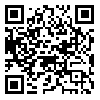BibTeX | RIS | EndNote | Medlars | ProCite | Reference Manager | RefWorks
Send citation to:
URL: http://ohhp.ssu.ac.ir/article-1-331-en.html
Introduction: Ethics is a pervasive subject which covers all aspects of human life. The rapid growth of human society and the complexity of social relations require the emergence of various professions. Survival of these professions depends on the type and quality of services they provide and the trust and credibility that they gain as a result of providing these services. To increase the impact of professional ethics, it is necessary to have patterns consistent with culture and society, and by recognizing them, the dimensions of safe behavior by accountants can be explored.
Research Method: This was an applied study in terms of purpose, and based on the research method, it was both quantitative and qualitative. The statistical population consisted of published domestic papers related to accounting professional ethics. In this study, effective criteria based on previous research were identified and selected in the form of 5 main indicators. Then, a researcher-made questionnaire was designed and implemented to determine the fuzzy cognition mapping pattern.
Findings: Fuzzy cognition mapping among 5 main components showed that there is a cause and effect relationship between all components. However, this cause and effect relationship is positive in some cases and negative in others. Results indicated that an individual component has a negative relationship with an organizational component and a positive relationship with other components. Social component has a positive relationship only with the individual component and a negative relationship with other components. In other words, social component is inversely related to organizational, professionalism and environmental indicators, and the highest intensity of the reverse flow is related to the environmental component.
Conclusion: By understanding professional ethics of accountants and identifying its basic components and determining the relationship between these components in different dimensions and specifying the importance of each of them, a specific framework or format can be designed and implemented for observing or not observing professional ethics by accountants and the desire to behave based on the code of professional behavior .This is to reduce unsafe behaviors, and as a result, reduce the rate of accidents in the country's industries.
Received: 2020/10/12 | Accepted: 2022/01/30 | Published: 2022/07/26
| Rights and permissions | |
 |
This work is licensed under a Creative Commons Attribution-NonCommercial 4.0 International License. |






